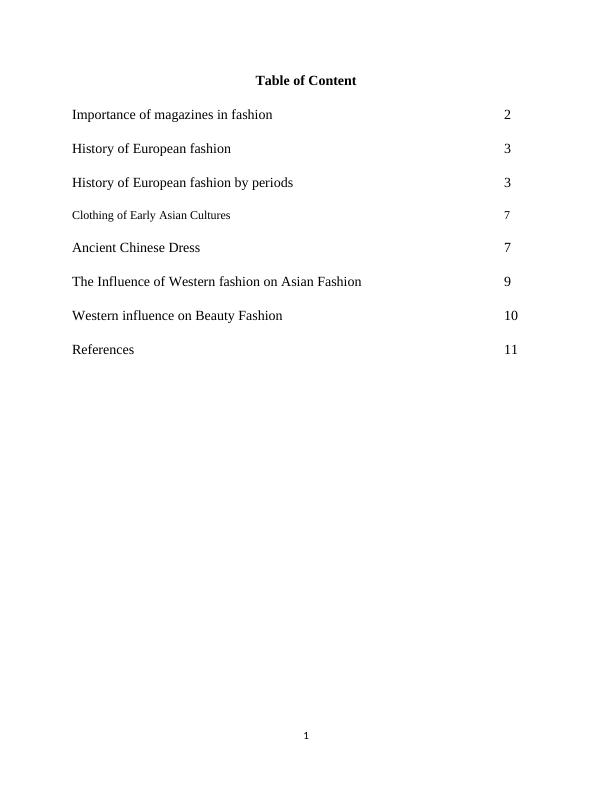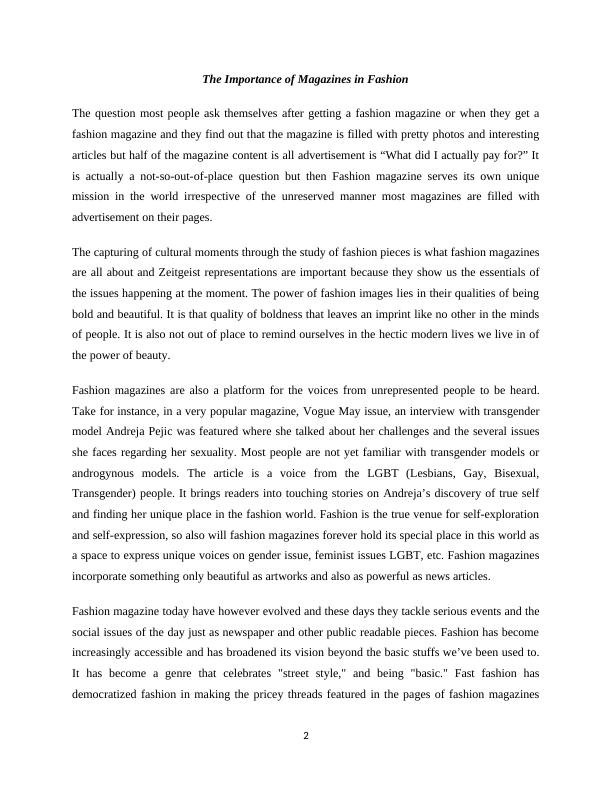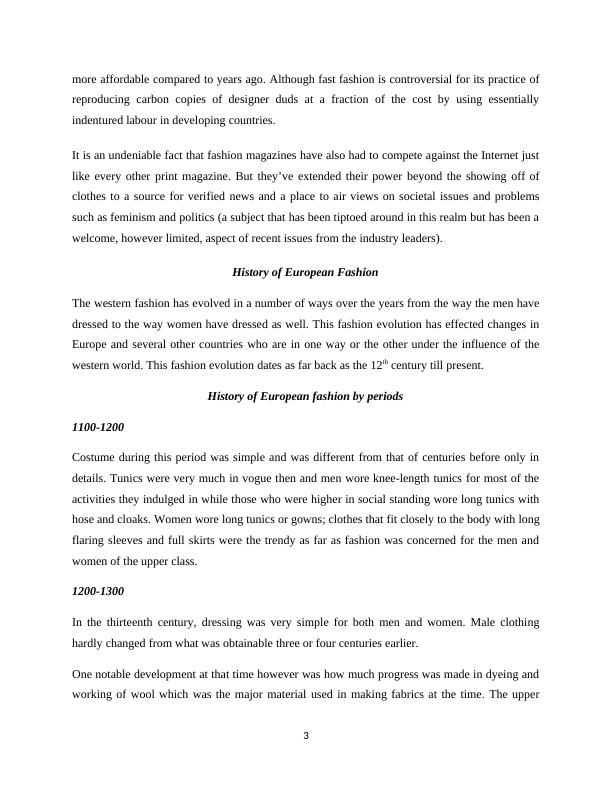The Importance of Magazines in Fashion
11 Pages3352 Words1598 Views
Added on 2020-02-05
The Importance of Magazines in Fashion
Added on 2020-02-05
ShareRelated Documents
Table of ContentImportance of magazines in fashion2History of European fashion3History of European fashion by periods3Clothing of Early Asian Cultures7Ancient Chinese Dress7The Influence of Western fashion on Asian Fashion9Western influence on Beauty Fashion10References 111

The Importance of Magazines in FashionThe question most people ask themselves after getting a fashion magazine or when they get afashion magazine and they find out that the magazine is filled with pretty photos and interestingarticles but half of the magazine content is all advertisement is “What did I actually pay for?” Itis actually a not-so-out-of-place question but then Fashion magazine serves its own uniquemission in the world irrespective of the unreserved manner most magazines are filled withadvertisement on their pages.The capturing of cultural moments through the study of fashion pieces is what fashion magazinesare all about and Zeitgeist representations are important because they show us the essentials ofthe issues happening at the moment. The power of fashion images lies in their qualities of beingbold and beautiful. It is that quality of boldness that leaves an imprint like no other in the mindsof people. It is also not out of place to remind ourselves in the hectic modern lives we live in ofthe power of beauty.Fashion magazines are also a platform for the voices from unrepresented people to be heard.Take for instance, in a very popular magazine, Vogue May issue, an interview with transgendermodel Andreja Pejic was featured where she talked about her challenges and the several issuesshe faces regarding her sexuality. Most people are not yet familiar with transgender models orandrogynous models. The article is a voice from the LGBT (Lesbians, Gay, Bisexual,Transgender) people. It brings readers into touching stories on Andreja’s discovery of true selfand finding her unique place in the fashion world. Fashion is the true venue for self-explorationand self-expression, so also will fashion magazines forever hold its special place in this world asa space to express unique voices on gender issue, feminist issues LGBT, etc. Fashion magazinesincorporate something only beautiful as artworks and also as powerful as news articles.Fashion magazine today have however evolved and these days they tackle serious events and thesocial issues of the day just as newspaper and other public readable pieces. Fashion has becomeincreasingly accessible and has broadened its vision beyond the basic stuffs we’ve been used to.It has become a genre that celebrates "street style," and being "basic." Fast fashion hasdemocratized fashion in making the pricey threads featured in the pages of fashion magazines2

more affordable compared to years ago. Although fast fashion is controversial for its practice ofreproducing carbon copies of designer duds at a fraction of the cost by using essentiallyindentured labour in developing countries.It is an undeniable fact that fashion magazines have also had to compete against the Internet justlike every other print magazine. But they’ve extended their power beyond the showing off ofclothes to a source for verified news and a place to air views on societal issues and problemssuch as feminism and politics (a subject that has been tiptoed around in this realm but has been awelcome, however limited, aspect of recent issues from the industry leaders).History of European FashionThe western fashion has evolved in a number of ways over the years from the way the men havedressed to the way women have dressed as well. This fashion evolution has effected changes inEurope and several other countries who are in one way or the other under the influence of thewestern world. This fashion evolution dates as far back as the 12th century till present.History of European fashion by periods1100-1200Costume during this period was simple and was different from that of centuries before only indetails. Tunics were very much in vogue then and men wore knee-length tunics for most of theactivities they indulged in while those who were higher in social standing wore long tunics withhose and cloaks. Women wore long tunics or gowns; clothes that fit closely to the body with longflaring sleeves and full skirts were the trendy as far as fashion was concerned for the men andwomen of the upper class.1200-1300In the thirteenth century, dressing was very simple for both men and women. Male clothinghardly changed from what was obtainable three or four centuries earlier.One notable development at that time however was how much progress was made in dyeing andworking of wool which was the major material used in making fabrics at the time. The upper3

class people took colors important and the introduction of the Blue Color was widely accepted.Even the king of France made blue their heraldic colour.In the 14th century, different forms of clothing were experimented and by the middle of thecentury, recognizable fashion emerged in the history of clothing. Clothes form centuries before(draped garments and straight seams) were replaced with carried seams. This signaled the start ofproper tailoring which gave way to making fitted wears and buttons were introduced to makeclothes more fitting.In the 15th century, Europe had begun to develop the more, people started wearing more complexclothes and it was at this time trend set in. people could be defined by the type of clothes theyhad on either out of date or trendy, clothing became a thing of social concern and justification.By the 16th century clothing had become something used to show off. New designs came up inthe introduction of slashes embroidery and addition of surface ornaments to fabric. Womenwears had wide skirts and sleeves and these got carried into the 17th century. During this period,the most common garment was ruff which at first was a ruffle that was attached to the neckbandof a shirt and later transited into a separate garment of fine linen, trimmed with lace orembroidery and shaped into precise crisp folds with starch and hot iron.The 18th century brought about a widening silhouette for both men and women. Highly placedmen in the society wore often white, sometimes natural hair was powdered to create thatfashionable look.It was during this period that a clear distinction was made between wears for formal occasionand every day, daytime wears.The start of the 19th century brought about a transition of fashionable women’s clothing stylefrom the classically influenced “Europe/Regency” styles to the readoption of elements that hadbeen characteristics of most of the 18th century which eventually made up the remainder of the19th century such as clearly visible corseting of the natural waist and full skirts.The silhouette of men’s fashion also changed in similar ways. Coats were designed with broadshoulder and puffed sleeves, full skirts and a narrow waist. Trousers were designed to be smarton the body while the use of breeches was continued in court and country fashion.4

End of preview
Want to access all the pages? Upload your documents or become a member.
